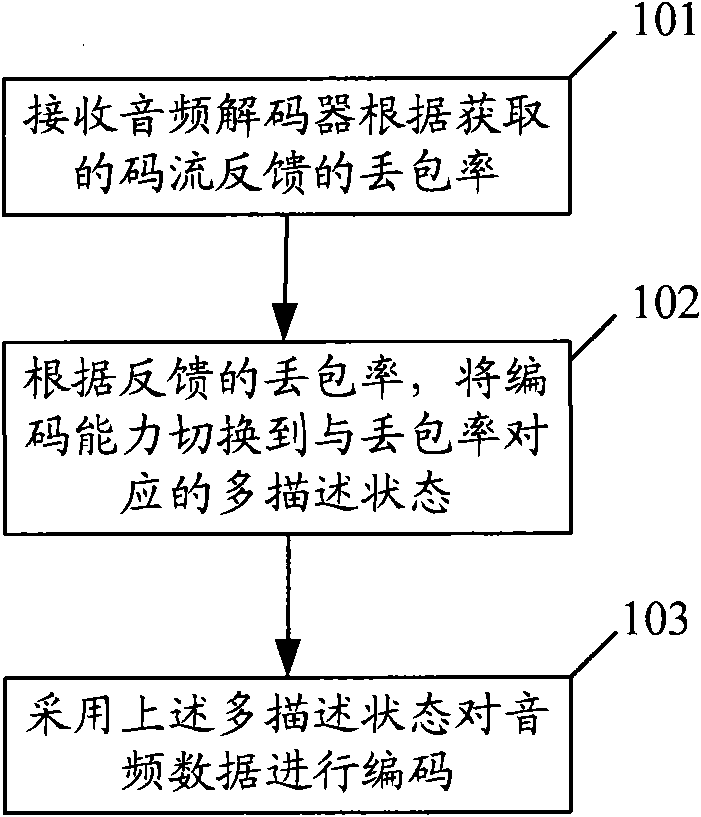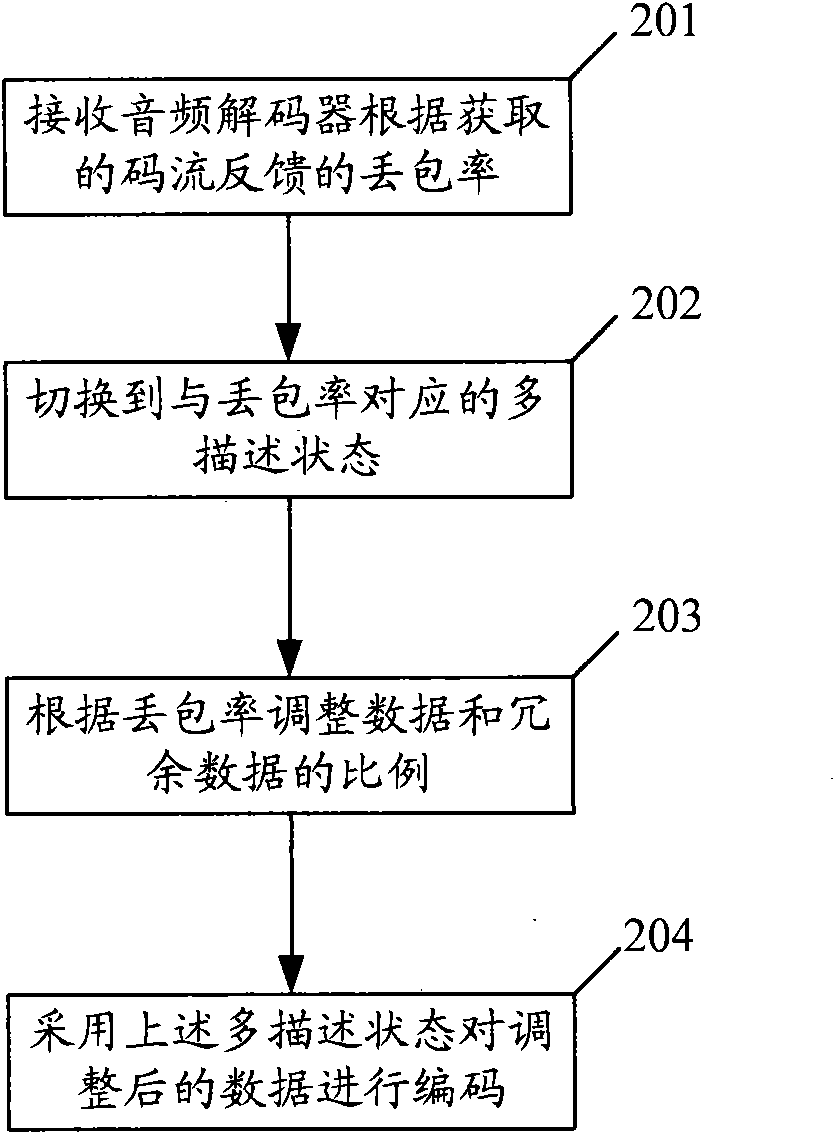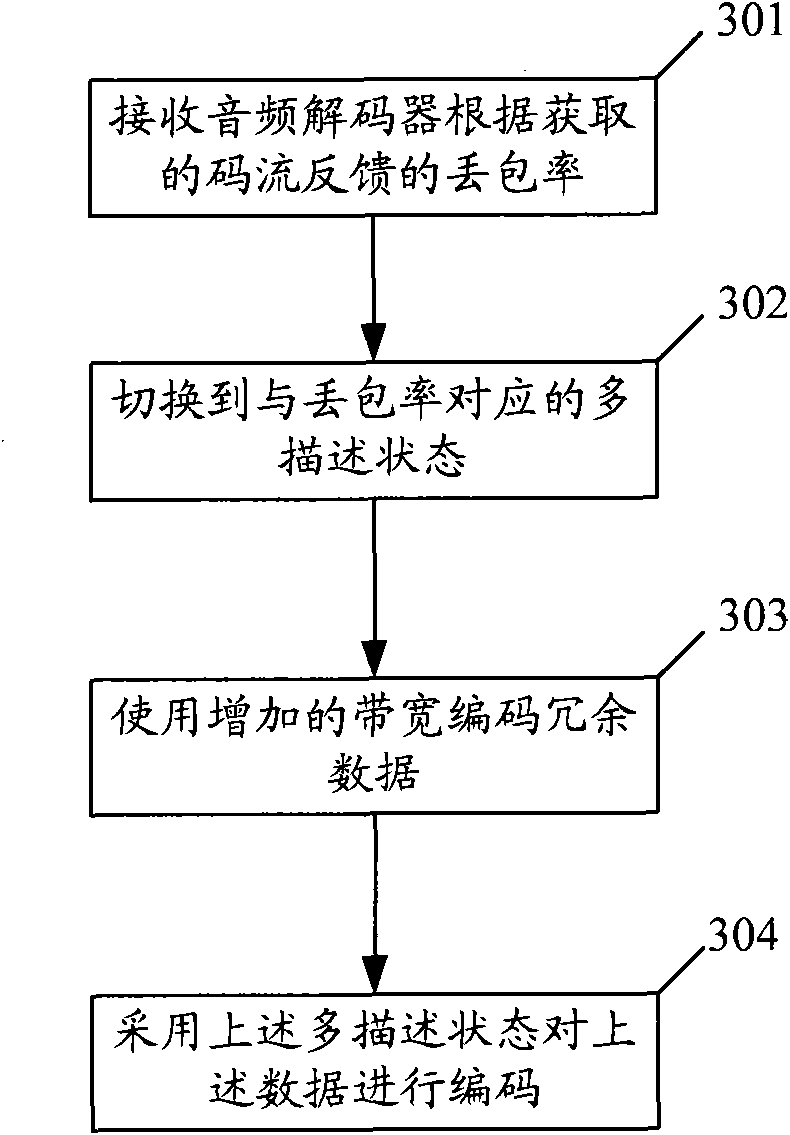Audio encoding method, audio decoding method, related device and communication system
An audio coding and audio decoding technology, which is applied in the field of communication, can solve the problems of adjusting redundancy, audio quality degradation, and inability to enhance anti-packet loss performance, so as to achieve the effect of reducing bandwidth and improving the quality of output code stream
- Summary
- Abstract
- Description
- Claims
- Application Information
AI Technical Summary
Problems solved by technology
Method used
Image
Examples
Embodiment 1
[0050] This embodiment describes an audio coding method, see figure 1 , the method may include the following steps:
[0051] Step 101: receiving the packet loss rate fed back by the audio decoder according to the acquired code stream;
[0052] The audio encoder first sends the encoded code stream to the audio decoder. At this time, any kind of multi-description state can be used for encoding, but usually a single description is used because there is no redundant information in a single description. After the audio encoder sends the encoded code stream to the audio decoder, the audio decoder performs packet loss rate statistics according to the received real-time transport protocol serial number, and then feeds back the packet loss rate to the audio encoder through the real-time control protocol.
[0053] The packet loss rate fed back from the audio decoder to the encoder may be transmitted using the same channel as the coded stream sent from the audio encoder to the audio dec...
Embodiment 2
[0062] The audio coding methods described in Embodiment 2 and Embodiment 3 are applicable to different application scenarios. When the network bandwidth that can be occupied is fixed and cannot provide more bandwidth or occupy more bandwidth, the method described in Embodiment 2 is adopted. When the network is available The bandwidth has certain flexibility, and when other services can provide part of the bandwidth for the audio service, the method described in Embodiment 3 is adopted, so that the decoding quality of the audio code stream can be better guaranteed.
[0063] Embodiment two
[0064] This embodiment describes a method for establishing a dynamic relationship between redundancy and packet loss rate, affecting the increase or decrease of redundancy of an encoder through changes in packet loss rate, and simultaneously adjusting the anti-packet loss performance of a code stream.
[0065] The multi-description audio encoder has single-description, two-description, three...
Embodiment 3
[0076] This embodiment describes an audio coding method in which the available bandwidth of the network has certain flexibility, and other services can provide part of the bandwidth for use by audio services.
[0077] The single description, two descriptions, three descriptions and four descriptions supported by the multi-description encoder uniformly use a fixed bit rate to encode effective audio data, and additionally increase bandwidth encoding data redundancy. As the number of encoded streams, that is, the number of descriptions increases, the redundancy Increase. No matter how many descriptions are used for such an audio code stream, when all the code streams are obtained, they all have the same audio quality. The network bandwidth required for single description, second description, third description, and four descriptions increases sequentially.
[0078] see image 3 , the method of this embodiment includes the following steps:
[0079] Steps 301 to 302 are the same ...
PUM
 Login to View More
Login to View More Abstract
Description
Claims
Application Information
 Login to View More
Login to View More - R&D
- Intellectual Property
- Life Sciences
- Materials
- Tech Scout
- Unparalleled Data Quality
- Higher Quality Content
- 60% Fewer Hallucinations
Browse by: Latest US Patents, China's latest patents, Technical Efficacy Thesaurus, Application Domain, Technology Topic, Popular Technical Reports.
© 2025 PatSnap. All rights reserved.Legal|Privacy policy|Modern Slavery Act Transparency Statement|Sitemap|About US| Contact US: help@patsnap.com



